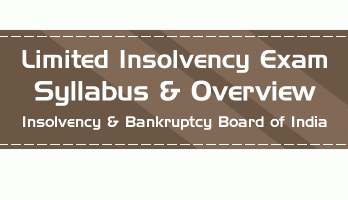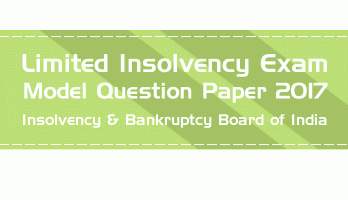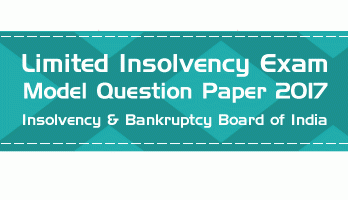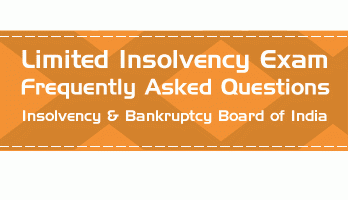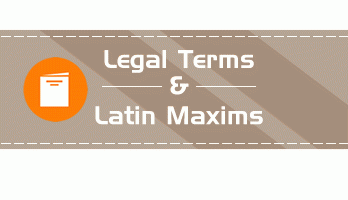51. A valid Agreement is one which ___________.
a) creates legal and social obligations of the parties
b) creates rights of a party
c) is written on a piece of paper and signed by the parties
d) creates legally binding rights and obligations of the parties to it
Ans. (d)
52. A contract in which one person promises to compensate the other person for the loss suffered by him, due to the conduct of the promisor or of any other person, is known as________
a) contract of indemnity.
b) contract of guarantee.
c) quasi-contract.
d) contingent.
Ans.(a)
53. Under the Sale of Goods Act, 1930, ‘delivery’ means ___________________.
a) gratuitous transfer of possession from one person to another
b) involuntary transfer of possession from one person to another
c) voluntary transfer of possession from one person to another
d) transfer of possession irrespective of whether it is gratuitous, involuntary or
voluntary, from one person to another.
Ans.(c)
54. A transfers a garden to B for his life, with a proviso that, in case B cuts down a particular neem tree, the transfer shall cease to have any effect. B cuts down the tree. Decide the case in the light of Transfer of Property Act, 1882.
a) B loses his life interest in the garden.
b) B does not lose his life interest in the garden.
c) No such provision is made under the Transfer of Property Act, 1882.
d) The transfer was void.
Ans. (a)
55. Readiness under The Specific Relief Act,1983 may mean capacity of plaintiff to perform contract which does not include___.
a) performance of plaintiff
b) potential of plaintiff
c) willingness of plaintiff
d) financial ability of plaintiff
Ans.(b)
56. When an instrument has been lost as per the Negotiable Instrument Act,1881, until the contrary is proved, it shall be presumed that it was ________
a) expired
b) duly stamped
c) stolen
d) misplaced
Ans.(b)
57. Which of the following decides applications from the banks and financial institutions for recovery of debts due to them?
a) Debt Recovery Tribunal
b) Debt Recovery Appellate Tribunal
c) Securities Appellate Tribunal
d) Central Board of Direct Taxes
Ans. (a)
58. As per the Securitisation and Reconstruction of Financial Assets and Enforcement of Security Interest Act, 2002, what constitutes as ‘non-performing assets’?
a) An asset of a borrower which has been classified by a credit rating agency as doubtful.
b) An asset or an account of a borrower which has been classified by a bank as sub-standard or doubtful or loss asset.
c) An account for which a borrower has refused to repay.
d) An asset of borrower’s subsidiaries company.
Ans.(b)
59. The Hon’ble Supreme Court, in the matter of Mardia Chemicals Ltd. Vs. Union of India, held that the requirement of deposit of 75% of amount claimed before entertaining an appeal (petition) under Section 17 of the Securitisation and Reconstruction of Financial Assets and Enforcement of Security Interest, 2002 is _________
a) valid but in the interest of justice, amount to be deposited should be reduced to 45%.
b) arbitrary condition against all the canons of reasonableness.
c) mandatory and must be complied with.
d) a matter of executive prerogative and court can’t interfere in it.
Ans.(b)
60. The Arbitration agreement as defined in Section 7(2) of The Arbitration and Conciliation Act, 1996 may be:
a) in form of contract and a separate agreement
b) in form of contract and a written agreement
c) may be in the form of an arbitration clause in a contract or in the form of a separate agreement
d) implied oral agreement.
Ans.(c)
61. In computing the period of limitation of any suit for the execution of a decree, the institution or execution of which has been stayed by injunction or order, the time of the continuance of the injunction or order from the day on which it was ______ shall be excluded.
a) Issued
b) Filed
c) Admitted
d) First heard
Ans. (a)
62. “S4A” scheme of RBI stands for_________
a) Scheme for Sustainable Structuring of Stressed Assets
b) Scheme for Schematic Structuring of Stressed Assets
c) Scheme for Sustainable Structuring of Systemic Assets
d) Scheme for Schematic Structuring of Systemic Assets
Ans. (a)
63. Which of the following is most appropriate for measuring a bond’s sensitivity to shaping risk?
a) Key rate duration
b) Effective duration
c) Modified duration
d) Median duration
Ans.(a)
64. Exchange markets and Over the Counter Markets are considered as two types of – ___________.
a) Inter market
b) Primary market
c) Secondary market
d) Risky market
Ans. (c)
65. Which of the following represent the standard of living in a country?
a) National Income
b) Per capita income
c) Poverty ratio
d) Unemployment rate
Ans. (b)
66. The Policy Repo Rate is ______ the Reverse Repo rate.
a) higher than
b) lower than
c) equal to
d) 75% of
Ans. (a)
67. Which of the following is not a settlement machinery appointed by the appropriate authority for the settlement of the industrial disputes under the Industrial Disputes Act, 1947?
a) Conciliation officers
b) Labour Courts
c) Board of Arbitrators
d) Courts of Inquiry
Ans.(c)
68. Minimum wages must be paid in
a) cash only.
b) kind only.
c) either cash or in kind.
d) cash ordinarily and in kind to the extent authorised by the appropriate government.
Ans.(d)
69. Balance sheet of a company does not show________
a) what the company owns and what the company owes.
b) assets and liabilities of the company.
c) financial health of the company.
d) income and expenditure of the company.
Ans. (d)
70. Basic Earnings per Share (EPS) is calculated as __________.
a) Net profit /total number of shares
b) (Net profit – preferred dividend)/weighted average number of outstanding shares
c) (Net Profit – Preference Share Capital) /Average shares outstanding
d) (Net Profit – Dividend) /Total shares outstanding
Ans.(b)
71. A firm can enhance its value by______
a) increasing working capital.
b) increasing capital expenditure.
c) decreasing cost of capital.
d) increasing debt.
Ans. (c)
72. How is cash management different than liquidity management? a) Cash management deals with only one account, while liquidity management
involves everything on the balance sheet.
b) Cash management only considers the current financial reporting period, while liquidity management looks out 2-3 years.
c) Cash management only considers cash, while liquidity management considers assets that are considered liquid.
d) Cash management is essential to financial reporting, while liquidity management is just a good practice.
Ans.(c)
73. Who will pay GST in case, the business in respect of which any tax, interest or penalty is payable under CGST Act is carried on by a minor, or other incapacitated person on behalf of and for the benefit of such minor or other incapacitated person?
a) Guardian
b) Partner
c) Director
d) Exempted to pay tax
Ans. (a)
74. The process whereby a company sells its receivables to a collection agent in order to secure a cash sum which is at a discount to the face value of the receivables is termed as ________________process.
a) Debt factoring
b) Credit factoring
c) Sell per se
d) Cash Collection
Ans. (a)
75. In the case of Smart Timing Steel Ltd. V. National Steel and Agro Industries Ltd. (Company Appeal (AT) (Insolvency) No. 28 of 2017), the NCLAT held that:
a) the provision regarding the furnishing of a copy of the certificate from the Financial Institution maintaining accounts of the operational creditor confirming that there is no payment of unpaid operational debt by the corporate debtor is mandatory
b) the provision regarding the furnishing of a copy of the certificate from the Financial Institution maintaining accounts of the operational creditor confirming that there is no payment of unpaid operational debt by the corporate debtor is directory
c) the provision regarding the furnishing of a copy of the certificate from the Financial Institution maintaining accounts of the operational creditor confirming that there is no payment of unpaid operational debt by the corporate debtor is ultra vires the Insolvency and Bankruptcy Code, 2016
d) the provision regarding the furnishing of a copy of the certificate from the Financial Institution maintaining accounts of the operational creditor confirming that there is no payment of unpaid operational debt by the corporate debtor is unconstitutional
Ans (a).


